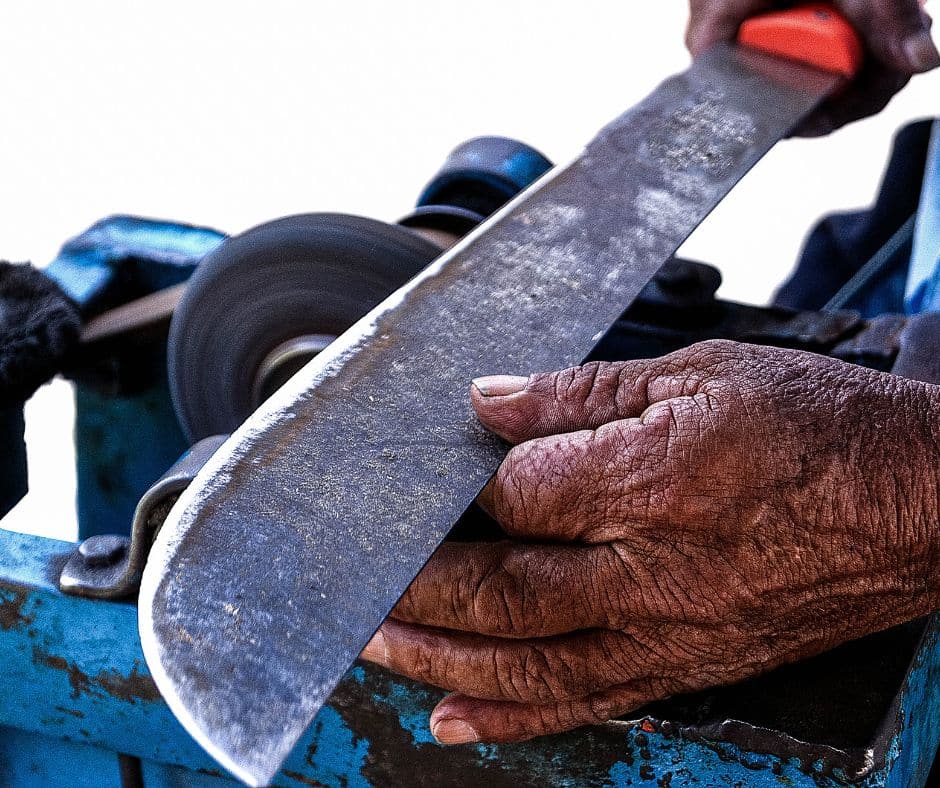In Costa Rica, you’ll spot it strapped to a belt, slung over a shoulder, or leaned against a banana tree. The machete isn’t just a tool here—it’s practically family. Passed from grandpa to grandson, sharpened daily, and spoken of with the same reverence usually reserved for a good horse or a trusty old truck, the machete is the quiet hero of Tico life. Whether it’s clearing a jungle path, harvesting sugarcane, or slicing open a fresh coconut with the flourish of a jungle ninja, this humble blade does it all—often before breakfast.

Why is the machete such a big deal in Costa Rica?
Because it’s the ultimate multitasker—equal parts tool, tradition, and lifestyle.
Cutting grass? Grab the machete.
Opening a beer? There’s a way.
Chopping wood, trimming trees, making fence posts, harvesting fruit, scaring off the odd snake? Check, check, check, and check.
The machete is the Swiss Army knife of the tropics—only longer, cooler, and way more dramatic when unsheathed with flair.
What are the everyday uses of a machete in Costa Rica?
A machete is used for everything from farm work to food prep, with surprising skill and precision.
Field clearing – Slash through thick grass, brush, or vines with rhythm and grace
Coconut cracking – A couple of swift thwacks and you’re sipping from nature’s canteen
Fence making – Slice bamboo, carve stakes, and hammer them in with the back of the blade
Harvesting – Whether it’s sugarcane, bananas, or yuca, a machete’s the go-to blade
Cooking – Peel, chop, and quarter like a countryside sous-chef
You haven’t really cooked gallo pinto until you’ve diced your onions with a 22-inch blade while fending off a curious chicken.
Who uses machetes in Costa Rica?
Just about everyone—from farmers to grandmothers—has a machete and knows exactly how to use it.
Tico ranchers – Trim trail paths, chop palm leaves, fix fence lines
Campesinos – Do fieldwork, garden, or carve walking sticks on the go
Hunters and foragers – Clear jungle, cut vines, and slice wild fruit
Abuelas – Open squash like it’s no big deal, while still in flip-flops
Kids (yes, kids) – Learn early and safely how to respect and wield the family machete
It’s not unusual to see a 10-year-old expertly trimming a plantain tree while humming along to salsa music on a Sunday morning.
How is the machete part of Costa Rican identity?
It represents simplicity, independence, and a deep connection to the land.
Symbol of hard work – It’s not just what you carry, it’s what you do with it
Cultural rite of passage – Receiving your first machete is like getting your first bike
Tico ingenuity – Need to open a can, cut rope, fix a roof? There’s a machete move for that
Peaceful tool – Despite its size, it’s rarely used as a weapon. It’s about function, not fight
In the hands of a Costa Rican, the machete is more magic wand than weapon. It turns jungle into homestead and chaos into order, all with a flick of the wrist.
What should you know before using a machete?
It’s all about technique, respect, and never swinging wildly like you’re in an action movie.
Keep it sharp – A dull blade is more dangerous than a sharp one
Use the rhythm – Chopping with flow saves energy and limbs
Mind your toes – No, really. Flip-flops and machetes are a risky combo
Respect the tool – It’s not a toy or souvenir; it’s a serious instrument of rural life
Get a sheath – Bonus points if it’s homemade from leather or repurposed inner tube
Pro tip: Want to look like you know what you’re doing? Carry it blade-down, tip-forward. Casual. Confident. Like a local.
FAQ
Is it legal to carry a machete in Costa Rica?
Yes, especially in rural areas where it’s clearly a working tool. Just don’t wave it around in San José.
Do Costa Ricans actually cook with machetes?
Absolutely. From chopping fruit to splitting open root vegetables, the machete is a regular part of many outdoor kitchens.
Can I buy one as a souvenir?
Yes, but make sure it’s packaged safely for travel, and maybe leave the full-size one at home if you’re flying carry-on.
Are machetes dangerous?
Only if misused. In Costa Rica, they’re handled with care and respect, like a hammer, but way cooler. What size machete is common?
The most common blades range from 18 to 24 inches—big enough for real work, but small enough to control.






